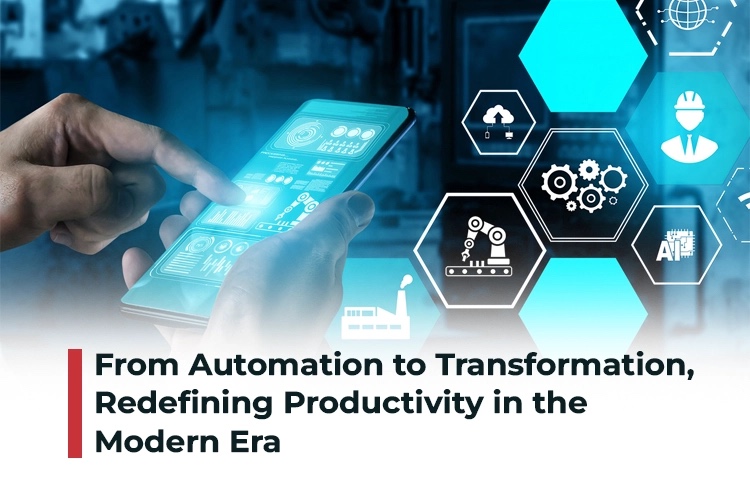
From Automation to Transformation, Redefining Productivity in the Modern Era
In the digital age, businesses are experiencing a seismic shift in how they define and achieve productivity. Automation, the Internet of Things (IoT), and data-driven insights are at the forefront of this transformation, enabling companies to streamline operations, enhance decision-making, and create more efficient workflows. These technologies not only help reduce costs but also open up new avenues for innovation, enabling businesses to achieve greater scalability, agility, and responsiveness. Let’s dive deeper into how automation, IoT, and data-driven insights are reshaping traditional business processes and redefining productivity in the modern era.

1. Automation: Making Your Company More Efficient Scale
This means Automation is simply technology in order to do tasks that humans might do in business processes. Automation used to be focused on factories and assembly lines but now, automation can be applied far beyond physical activities. From automated marketing workflows to AI-based customer service bots, automation is enabling organizations to minimize time loss on repetitive work, increase accuracy and reduce operational costs.
Robotic Process Automation (RPA):
This technology enables businesses to automate rule-based processes like data entry, invoice generation, and payroll processing. Personalized chatbots help in handling such errors, and considering cost-saving, RPA can do it for most repetitive and tedious tasks where human intervention is not required.
Artificial Intelligence and Machine Learning:
- Automation driven by AI that goes outside the lines of rules based action. It helps algorithms recognize patterns, predict trends, and develop natural decisions. In the customer service sector, artificial intelligence powered chatbots offer 24/7 assistance adapting over time from old conversations to generate a personalized and efficient response
Smart Automation in Manufacturing:
The advent of Industry 4.0 has ushered in smart automation in the manufacturing space, with machines outfitted with sensors and linked up to centralized systems. These systems can autonomously adapt operations based on real-time data, which leads to reduced waste, improved quality control, and less downtime.
2. The Internet of Things (IoT): Data at Your Fingertips
Internet of Things (IoT) — The internet of things (IoT) is revolutionizing productivity by integrating devices, sensors, and machines into the internet to gather and share data in real-time. It allows formerly isolated systems to be intelligent and creates a more integrated, data-driven world, improving business processes across sectors
Smart factories and Predictive Maintenance:
For manufacturing, IoT enabled sensors on machines capture data regarding performance, wear-and-tear, and operational efficiency. It collects massive amount of data from the machine sensors, which is then used to analyse when a machine is most likely to fail, allowing the company to perform predictive maintenance and reduce downtime.
Supply Chain Optimization:
IoT allows organizations to track goods in real-time as they pass through the supply chain. RFID tags, GPS trackers, and IoT sensors allow businesses to monitor their inventory levels, track their deliveries, and update their routes accordingly with up-to-the-minute data, resulting in more efficient logistics operations.
Energy Efficiency
Businesses use IoT for purposes of energy management as well. Sensors track energy use across operations, enabling companies to detect inefficiencies and reduce energy costs.
3. Data-Driven Insights: Reimagining Decision-Making
In today’s business landscape, data is king How you collect, examine and respond to data has positioned itself as a key differentiator. Data-driven insights enable organizations to take more intelligent, knowledgeable choices, be it optimizing marketing strategies, enhancing customer experiences, or improving operational efficiency.
Big Data Analytics:
With the help of big data tools and platforms, organizations can analyze huge volumes of both structured and unstructured data. This data, coupled with advanced analytics, allows companies to forecast market trends, discover new opportunities, rewrite the rules of customer interaction, and do things that would have seemed impossible 20 years ago.
Predictive Analytics:
Businesses can predict trends, anticipate customer preferences and make proactive decisions by applying machine learning algorithms to historical data. In retail, for instance, businesses can use predictive analytics to forecast the demand of products and stock up accordingly.
Agile Decision-Making:
Real-time data allows companies to pivot if market conditions change. Whether monitoring social media sentiment or tracking performance metrics, real-time insights have allowed companies to react faster and stay ahead of the competition.
4. Is an Most Models of Automation, IoT, and Data-Driven Insights
When you layer automation, IoT, and data driven insights on top of each other, they create a powerful ecosystem that can reshape industries.
IoT and Data Smart Automation:
For example, take a logistics company that uses IoT sensors to monitor the condition and location of the vehicle, automation to plot the route for delivery, and predictive analytics to predict potential delays. Such integrated systems enable cross-platform data sharing, enhancing efficiency and customer experience.
– AI-Powered Decision-Making:
By using AI and machine learning tools, you can make decisions based on real-time data that is being gathered from IoT devices, which lets you achieve better productivity overall. Take an example, in a factory its AI based environment can dynamically schedule production when it finds any machine is underutilized using real-time data from machines.
Personalization and Customer Experience**: Data-driven insights can be used to address customer pain points, enabling businesses to offer more personalized and tailored customer experiences. From personalized recommendations and targeted advertising to dynamic pricing models, these technologies enable businesses to better respond to individual customer needs.
FAQ: What’s Behind the Productivity Shift?
- How workplace workforce productivity is affected by automation
Automation improves productivity in the workforce, for it minimizes the time spent on routine and low-value work. That allows employees to concentrate on higher-value tasks that require creativity, critical thinking and problem-solving. Again as said here, automation minimizes errors, as businesses become more streamlined.
- The advantages of IoT in business operations.
Benefits of IoT in Business Operations With up to date monitoring of machine utilization, material (inventory) consumption, and supply chain status the IoT streamlines the process to reduce operational expenses. By enabling faster, more accurate decision-making, they are able to help businesses minimize downtime, optimize inventory and improve the customer experience.
- How does data-driven insights improve decision making?
Data driven insights enable businesses to make more data informed and timely decisions. Through handling massive amounts of data, companies can discover trends, foretell developments, and polish game plans. This enables better customer experiences by improving resource allocation, quick adaptation to market changes, etc.
- How does AI fit into the picture of automation?
The automation takes a giant leap into the next sphere — AI. Similar to humans, AI is able to analyze data, make decisions, and learn from its experiences to enhance future results. AI chatbots, for instance, don’t just respond to customer queries; they adjust their responses based on prior interactions, resulting in a more personalized experience.
- Why use automation and IoT for small business?
Absolutely! Automation and IoT are not reserved for the big players. These technologies can also help small businesses automate administrative processes, streamline inventory management, and improve customer service. Low-cost IoT devices and automation tools allow businesses of all sizes to enter the race, providing smaller organizations with the ability to compete at a greater level.
- How automation, IoT, and data-driven insights drive each other?
Together, these technologies form an integrated, cohesive system. IoT devices generate real-time data that can help analyze through AI-powered tools, whereas automation systems according to this data to make decisions or trigger actions. These synergize to allow companies to operate more effectively, adapt quickly to shifting, as well as develop improved products or solutions.
At the time of technology, productivity is not just about working harder anymore, it’s about working smarter. Automation, IoT, and data-informed decisions-Revolutionizing business operations, decision-making processes, and value delivery You can then create industries from these new sectors or devices in turn help growth and innovation. The potential for transformation will remain as long as companies continue to adapt and incorporate technologies like this.

infinigent consulting Ltd
infinigent Consulting Ltd. is a multinational strategic management consulting firm operating in India, Canada, and Bangladesh, with plans to expand to Singapore and Dubai. Our diverse team of international and local experts delivers tailored solutions to address business challenges. By closely collaborating with clients, we focus on improving organizational performance through customized, effective strategies.